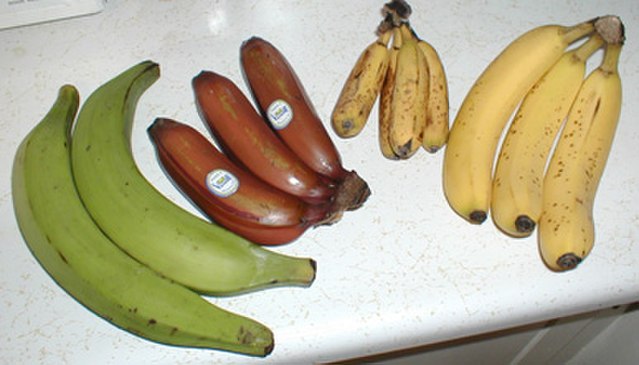Description
Bananas can be classed into diploid, triploid, and tetraploid kinds with various amounts of the A or B parents. They grow 6.5 - 30 feet (2-9 m) high. They are large non-woody herbs with broad long leaves. Most kinds have several suckers. Bananas grow a soft firm false stem from an underground corm. The fruiting stalk eventually emerges from the top of this false stem and normally curves over pointing towards the ground.
Recommended Varieties for Sri Lanka:
- Nadee River (Embul-AAB): High-quality sour banana, light green stem, large cans (about 15 kg).
- Kandula (Dual Purpose-AABB): Quadruple hybrid, can be used as fruit and vegetable, dark purple to black stem, drought and wind resistant.
- Pulathisi (Cooking banana-ABBB): Quadruple hybrid, drought and wind resistant, suitable for vegetables and products.
- Prasad (Ash plantain-ABB): Local gray banana selection, suitable for both dry and wet zones.
- Agra (Kolikuttu-AAB): High-quality Kolikuttu selection, good yield in dry zone under irrigation.
- Parakum (Seeni Kesel-ABB): High-quality sugar banana selection.
- Millewa Suwandel (Suwandel-AAB): Quality fragrant banana, suitable for wet zone.
- Gannoruwa Seeni 1 (Seeni Kesel-ABB): Superior quality sugar banana, resistant to Panama disease.
- Gannoruwa red banana (Rath Kesael-AAB): Extra large cans, superior quality and taste.
Other varieties grown in Sri Lanka include Ambon (AAA), Anamalu (AAA), Mondan (ABB), Kitala (ABB), Atamuru (ABB), and Bing Banana (AAA).
Planting requirements
Planting season: February to March and October to November
Planting conditions:
| Propagation | Young plant suckers |
|---|---|
| Planting method | Suckers are usually put 30 cm deep |
| Soil | Requires a soil pH between 5.5 - 6.5 and fertile soil with good drainage |
| Water | Bananas require a large amount of water for healthy growth. Needs a moist soil that drains well |
| Light | Requires full sunlight |
Growing conditions:
| Temperatures | Best temperature range is 15°C - 38°C, with 27°C being optimal |
|---|---|
| Soil | Bananas are heavy feeders and therefore respond well to manure. |
| Water | Require watering every day but avoid waterlogging. Watering from a garden hose or drip irrigation is best |
| Pruning | Prune the plant after harvesting to encourage new growth. |
| Weed control | Keep the area around the plants weed-free to prevent competition for nutrients and water |
Harvesting
The ideal time for harvesting is 12 weeks from flowering and should be done in the morning or evening.
Curing
Bananas are cured after harvesting by hanging them in a dark, humid place for about a week to allow the flavors to develop.
Storage
Store bananas at room temperature away from direct sunlight. They can also be frozen or dried for later use.
Protecting your plants
Pest Control
Pest type:
- Banana Weevil (Cosmopolites sordidus)
- Stem Weevil (Odoiporus longicollis)
- Banana Aphid (Pentalonia nigronervosa)
- Banana Rust Thrips (Chaetanaphothrips signipennis)
- Nematodes (e.g., Radopholus similis)
Symptoms:
- Banana Weevil: Wilting and yellowing of leaves; holes in the pseudostem with jelly-like sap oozing out
- Stem Weevil: Damage to the pseudostem, causing weakening and potential collapse
- Banana Aphid: Yellowing of leaves and stunted growth due to sap-sucking
- Banana Rust Thrips: Staining and splitting of the banana peel, leading to rotting flesh
- Nematodes: Corm rot, yellowing leaves, and reduced growth
Control method:
- Banana Weevil: Use of chemical insecticides; biological control options like Piaesius javanus (limited effectiveness)
- Stem Weevil: Insecticides specifically targeting weevils; remove infested plants
- Banana Aphid: Insecticidal sprays; maintain plant health to reduce susceptibility
- Banana Rust Thrips: Apply insecticidal dust or sprays; use polyethylene bagging for young fruit
- Nematodes: Apply nematicides; implement soil management practices such as fallowing and solarization
Disease Control
Disease type:
- Panama disease (Fusarium oxysporum f.sp. cubense)
- Anthracnose (Colletotrichum spp.)
- Black Sigatoka leaf spot disease (Mycosphaerella fijiensis)
- Kodana leaf spot disease (Cordana musae)
- Banana Bunchy Top Virus (BBTV)
- Moko Disease (Ralstonia solanacearum)
- Banana Bract Mosaic Virus
Symptoms:
- Panama disease: Brown discoloration in pseudostem and corm, wilting, yellowing leaves; internal vascular discoloration
- Anthracnose: Black circular spots on fruit during ripening, appearing as clusters of black spots post-harvest
- Black Sigatoka: Dark brown spots parallel to lateral veins on upper leaves; can reduce yields by 35-50%
- Kodana leaf spot: Oval spots on leaf blade with brown-gray center, concentric ring pattern, and yellow halo
- Banana Bunchy Top Virus: Stunted growth, yellow mottling on leaves, and malformed bunches
- Moko Disease: Yellowing and wilting of young leaves; internal vascular discoloration leading to plant death
- Banana Bract Mosaic Virus: Greenish-yellow streaks on leaves that turn necrotic; mottling on pseudostems
Management:
- Panama disease:
- Practice prevention: water regularly, avoid disposing diseased parts in waterways
- Crop rotation with resistant varieties
- Use healthy planting material
- Reduce soil acidity with dolomite or fly ash
- Quarantine measures; field flooding
- Anthracnose:
- Maintain field hygiene
- Apply fungicides containing mancozeb or chlorothalonil for susceptible varieties
- Cover banana bunches
- Black Sigatoka:
- Remove infected plants
- Regular fungicide applications
- Use resistant cultivars when available
- Kodana leaf spot: Cut off and burn infected leaves
- Banana Bunchy Top Virus:
- Remove infected plants
- Control aphid populations
- Moko Disease:
- Implement quarantine measures
- Destroy infected plants
- Banana Bract Mosaic Virus:
- Use disease-free planting materials
- Control vectors through insecticides
General practices:
- Obtain planting material from healthy mother plants or use tissue-cultured plants
- Maintain proper field hygiene and remove weeds
- Practice crop rotation when possible
- Use resistant varieties when available
- Implement quarantine measures for new plantings
Sources
In addition to our General List of Sources (link), we used these specific references:
- https://doa.gov.lk/fruit-crops-banana-s/
- https://www.epicgardening.com/plant-grow-and-care-for-banana-plants/
- https://growingspaces.com/growing-bananas/#:~:text=The%20following%20plants%20are%20great,grow%20up%20the%20banana%20plant.
- https://agritrop.cirad.fr/544321/1/544321.pdf
- https://plantvillage.psu.edu/topics/banana/infos
- https://doa.gov.lk/fruit-crops-banana-s/
